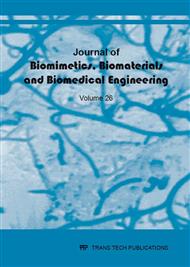p.13
p.19
p.28
p.45
p.60
p.66
p.73
p.84
p.93
FTIR Investigation of Rotational Spectra and Structural Change due to Deuterium Exchange in Bio-Molecule
Abstract:
This paper summarizes research on infrared absorption spectrum of gum Arabica, a Bio-material. The frequency shift due to deuterium exchange in gum Arabica molecule and rotational spectrum of bio-molecules are estimated from the measured data of FTIR spectra. The obtained shift of the characteristics frequency caused due to deuterium exchange in the –OH bond of gum Arabica. Normally two major region in the IR spectrum of a molecule are the functional group region ( 7000 cm-1 to 1500 cm-1) it includes the X-H stretching region and finger print region ( 1500 cm-1 to 350 cm-1). The mentioned region is very important in bio-molecular dynamics and it may provide much relevant information about the internal motion of the molecule and is related bio-molecular function in living systems. The change in molecular structure, of the constituent bio-molecules of Gum Arabica, due deuterium exchange is directly determined from analysis of FTIR spectrum in functional group region. The rotational constants as well as the ground state rotational energy levels are estimated from analysis of FTIR spectrum of the experimental specimens. A map of quantum energy levels of the bio-molecule has been extracted from this present FTIR analysis.
Info:
Periodical:
Pages:
73-83
Citation:
Online since:
February 2016
Authors:
Price:
Сopyright:
© 2016 Trans Tech Publications Ltd. All Rights Reserved
Share:
Citation:


